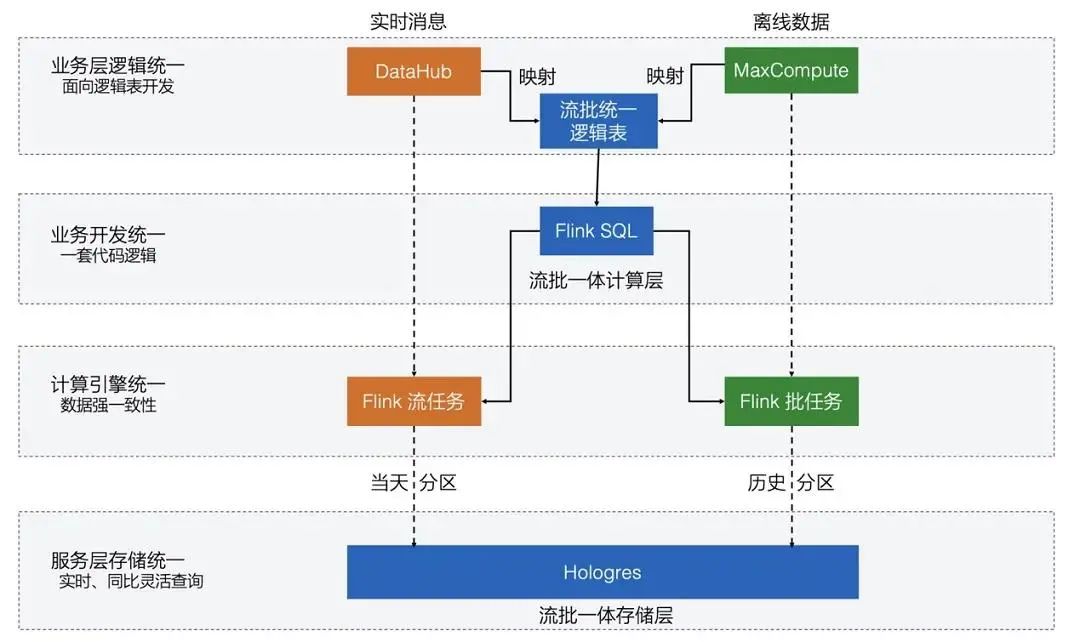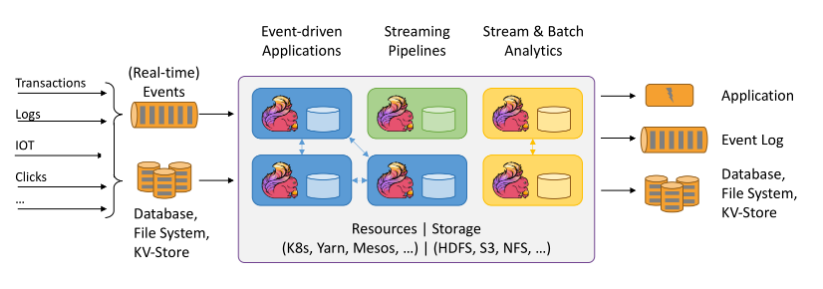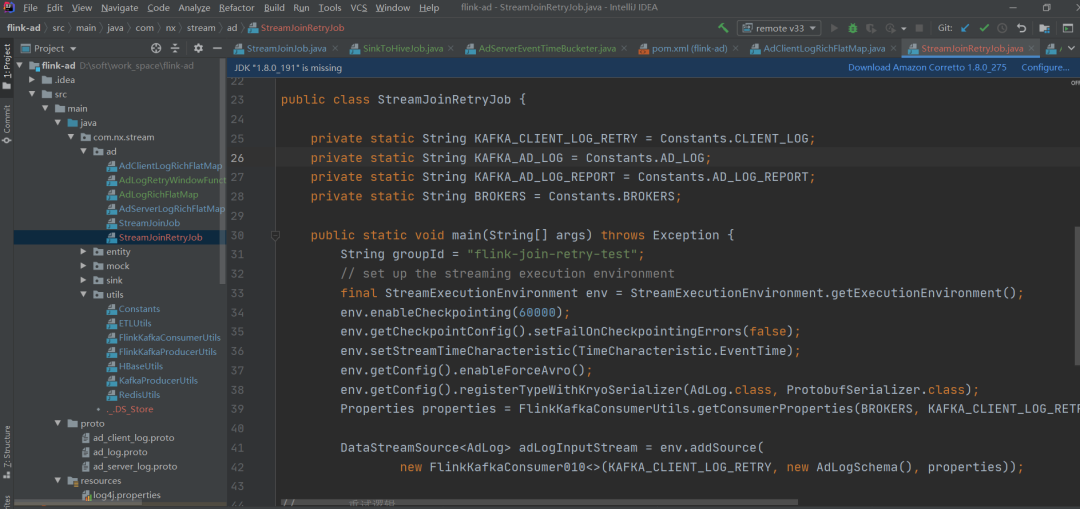本文共 2731 字,大约阅读时间需要 9 分钟。
身为大数据工程师,你还在苦学Spark、Hadoop、Storm,却还没搞过Flink?醒醒吧!刚过去的2020双11,阿里在Flink实时计算技术的驱动下全程保持了“如丝般顺滑”,基于Flink的阿里巴巴实时计算平台简直强·无敌。
最恐怖的是,阿里当时的实时计算峰值达到了破纪录的每秒40亿条记录,数据量也达到了惊人的7TB每秒,相当于一秒钟需要读完500万本《新华字典》!Flink的强悍之处,阿里已屡试不爽!

01
阿里为何坚定不移地选择Flink?
大数据起源于批处理,在批处理上,Spark有很深的积累。为了应对全球大量业务的实时需求,Spark也推出了流计算解决方案——SparkStreaming。但Spark毕竟不是一款纯流式计算引擎,所以在时效性等问题上,始终无法提供极致的流批一体体验。
而后起新秀Flink的基本数据模型则是数据流,以及事件(Event)的序列。数据流作为数据的基本模型,可以是无边界的无限“流”,即一般意义上的流处理;也可以是有边界的有限“流”,也就同时兼顾了批处理。

关于以上,阿里搜索事业部资深搜索专家蒋晓伟曾谈到:
Spark和Flink都具有流和批处理能力,但是他们的做法是相反的。Spark Streaming是把流转化成一个个小的批来处理,这种方案的一个问题是我们需要的延迟越低,额外开销占的比例就会越大,这导致了Spark Streaming很难做到秒级甚至亚秒级的延迟。Flink是把批当作一种有限的流,这种做法的一个特点是在流和批共享大部分代码的同时还能够保留批处理特有的一系列的优化。
同时,Flink相比于Spark而言还有诸多明显优势:
支持高效容错的状态管理,保证在任何时间都能计算出正确的结果;
同时支持高吞吐、低延迟、高性能的分布式流式数据处理框架;
支持事件时间(Event Time)概念,事件即使无序到达甚至延迟到达,数据流都能够计算出精确的结果;
轻量级分布式快照(Snapshot)实现的容错,能将计算过程分布到单台并行节点上进行处理。
阿里早在几年前就开始探索Flink的实战应用,随着2020双11阿里基于Flink实时计算场景的成功,毋庸置疑,Flink将会加速成为大厂主流的数据处理框架,最终化身下一代大数据处理标准。
02
Flink在千亿级海量数据场景的最佳实战
回归业务,在千亿级海量数据实时处理场景中,Flink如何落地应用?如何设计Flink StateBackend ?Flink两阶段提交核心源码有哪些?海量大数据去重普适架构又该怎么做?

头条基于Flink的统一广告流引擎推荐平台实战
碰巧我和前58技术委员会主席孙玄(江湖人称“玄姐”)聊过关于Flink的问题,玄姐认为:对数字化转型的公司来说,公司的业务可以分为两类:一类是OLTP型的业务,一类是OLAP型的业务。当今的大数据架构师需要掌握大数据采集、大数据ETL、大数据计算、大数据存储、大数据建模、大数据智能分析等多项技术能力,其中最核心的就是以Flink为首的大数据计算引擎。

计算引擎是整个大数据生态非常重要的一环,根据业务需求不同,大数据计算又分为离线批量计算和在线实时计算。比如基于MapReduce的海量计算属于离线计算范畴;基于ClickHouse的计算属于实时在线计算范畴。Flink就是一款既支持离线批量计算又支持实时在线计算引擎,无疑大数据开发/架构师必须具备的核心技能。
如果你想快速掌握阿里奉为“神器”的Flink计算引擎,我推荐你学习由前58技术委员主席孙玄联手58到家 CTO 沈剑老师,结合 10 多年一线大厂实践经验,打造的《大数据架构师必备技能—千亿级企业大数据计算引擎Flink State架构设计深度剖析与案例深度实践》在线专栏课。3天时间,直接让你在实践中了解Flink State架构设计的原理,学完能轻松应对大厂大数据资深开发/架构师面试!

原价 ¥499,限时 ¥9.8 立刻学习!

长按扫码????,锁定 ¥9.8 名额
仅前 50 人有效,先到先得!
学习最怕不成体系。如果你还在碎片化学习中消耗精力,我建议你花3天时间,每天集中学习几小时,通过课前问答、讲师答疑、课后作业闭环训练,快速有效地学习复杂的Flink高阶架构设计思维,实打实获取企业级大数据项目真实业务历练机会。
3月1日 - 3日,精品在线专栏课原价499,现在花9.8就能拿下!16个节点名师精心打磨的百万年薪架构师技术和思维模型实战课,绝对是市面超高质量的Flink计算引擎架构设计实战课,也是大数据架构师必须掌握的核心能力!
03
我为什么推荐给你这门课
前58技术委员会主席玄姐的技术实力和思维模型可谓有口皆碑,这次联手58到家CTO沈剑老师打造多线程编程与超高并发应用实战课程,目的就是为了让大家3天掌握千亿级企业大数据计算引擎Flink State架构设计这一难啃知识点,入职大厂不是梦!
3天搞定Flink State架构设计
千亿级企业海量大数据实战

超强名师带你学!



超强收获
掌握大数据计算引擎Flink生态体系架构设计,能够根据企业业务场景做好计算引擎技术选型;
掌握千亿级企业大数据计算引擎Flink核心技术设计(State/Checkpoint等)以及案例深度实践,能够知其然知其所以然;
深度掌握Flink 最具特色的State功能,能够以不变应万变;
掌握千亿级企业大数据计算引擎Flink 两阶段提交设计以及去重普适架构设计实践,能够应用自如;
掌握千亿级企业大数据计算引擎Flink企业级多业务场景整合Redis/HBase/Kafka的真实案例实践,够快速实现企业级复杂实时需求;
掌握千亿级企业SQL on Stream架构设计与企业真实实践,能够做到举一反三。
哪些人群适合学习
- 如果你是一名:
大数据开发工程师
数据仓库工程师
后端开发工程师(Java/Go/C++/PHP/Python等语言方向)
架构师(大数据/云原生/平台/系统/业务等方向)
分布式系统开发工程师
DBA/运维等方向转型大数据开发
- 那么这门 千亿级企业大数据计算引擎Flink State架构设计 精品课正是为你量身定做的!

大数据架构师都精通的实时计算“神器”
你需要真正掌握它!
16节点Flink千亿级实战硬核干货
3天速成精品课
原价499,限时扫码9.8
快速搞定Flink在大数据架构中的最佳实践!
????????????

长按识别,仅限前50名特惠购买
购买后请您耐心等待课程顾问通过
关于奈学教育

点击查看“阅读原文”,了解奈学教育更多课程内容!!
转载地址:http://gbgiz.baihongyu.com/